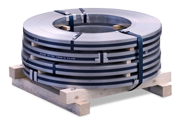Forks, spoons and knives have historically been made of silver in recognition of the anti-bacterial properties of this particular precious material. With the advent of the industrial era, a solution was needed to permit for the dissemination of the fork and spoon at more affordable prices. This led to the production of the brass forks and spoons. The resulting cutlery was then subjected to a silvering process to create more affordable products without sacrificing the advantages of silver.
It was not until around 1970 that forks and spoons began to be made out of stainless steel. Stainless steel has a number of properties that make it perfect for producing forks and spoons, in fact - it is very strong even at high temperatures, resistant to water and washing in dishwashers and, most importantly, resistant to rust.

One of the main properties of stainless steel is the hygiene that it ensures. This is why stainless steel is used for all forks and spoons in the parts where they come into contact with food. The handles, on the other hand, are usually made of other materials, such as: glass, wood, methacrylate or plastic. These materials allow designers and manufacturers to create shapes and colors that are always new and original.
There are three families of stainless steel:
 Austenitic stainless steel
Austenitic stainless steel
 Martensitic stainless steel
Martensitic stainless steel
 Ferritic stainless steel
Ferritic stainless steel
These three families of stainless steel are labeled with the American AISI stamp followed by a three-digit number that identifies its specifics.
The properties of stainless steel are:
 Resistance to corrosion
Resistance to corrosion
 Resistance to fire and heat
Resistance to fire and heat
 Hygiene
Hygiene
 Esthetic
Esthetic
 Better strength/weight ratio than other types of steel
Better strength/weight ratio than other types of steel
 Ease of transformation during the manufacturing process for making different types of parts and products
Ease of transformation during the manufacturing process for making different types of parts and products
 Wide range of usage temperatures (from high temperatures to cryogenic temperatures)
Wide range of usage temperatures (from high temperatures to cryogenic temperatures)
 High value throughout the product's entire life cycle
High value throughout the product's entire life cycle







